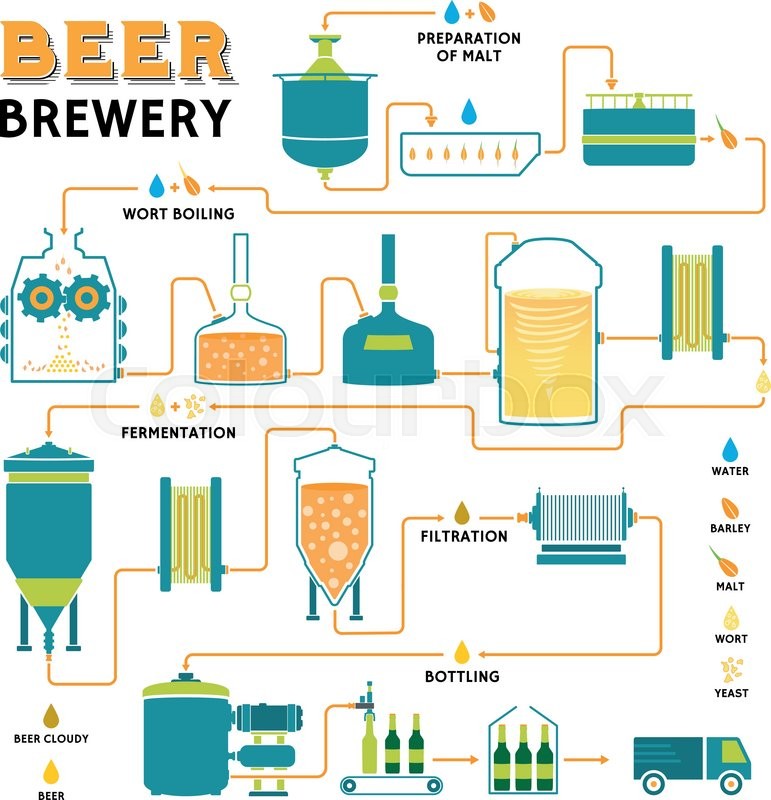
And maintain that brand as your craft beer business evolves and grows. Lagering begins from day 24 to around day 50.
Malt in beer must be pressed very finely so the producers employ hammer mills.
Steps to brew beer. Beer Brewing Steps Step 1. When harvested grain maltusually barleyarrives at the brewing facility it is crushed into grist by mills to release its sugars. Malt in beer must be pressed very finely so the producers employ hammer mills.
This equipment feeds the malt through a shaft in which multiple hammers pulverize the grain kernels. How to Make Beer Step 1. Gather your brewing equipment.
If gathering all of that sounds like too much work simply choose. Fill your 5-gallon brew kettle with 25 gallons of water. As you heat your water steep your.
Dont forget to. There are three major phases in the brewing process. Wort making fermentation and packaging.
Wort making is the step that requires the most work from the brewer as you make a perfect solution for brewers yeast to turn into tasty beer. Add half a teaspoon of demerera sugar into each bottle. Use a funnel will make it easier.
I used 15x 500ml beer bottles. Make sure they are proper beer bottles other bottlescontainers may be lible to explode under the carbon dioxide that will be produced within the bottle. At the brewery the malt is sent through a grist mill cracking open the husks of the kernels which helps expose the starches during the mashing process.
The process of steep milling or soaking the grain before milling is also an option for large-scale brewers. Beginning In the brew house different types of malt are crushed together to break up the grain kernels in order to extract fermentable sugars to produce a milled product called grist. The grist is then transferred into a mash tun where it is mixed with heated water in a process called mash conversion.
The conversion process uses natural enzymes in the malt to break the malts. Carbonating sugars are a mixture of 3-4 ounces of corn sugar and 1 or 2 cups of water. The mixture is poured into the brew kettle and the beer is siphoned back into the kettle.
Bottling beer is time-consuming but it is much more cost-efficient than kegging. The beer is siphoned into the bottles up to an inch from the top. A capper seats the cap on the bottle and the bottles will sit for 2 to 3 weeks at room temperature.
After that time the beer. As the polyphenols coalesce and fall at the bottom the beer becomes clearer and tastier. Lagering begins from day 24 to around day 50.
By this time you already have the beer perfectly fermented and its only time to refine the tastes and flavors. Lower the temperatures slowly from 60 to between 30 and 40 F. Then you will need to hold it on at this temperature for about 4 to 5 weeks.
In a separate brew kettle heat the sparge water to 200 o F. Our goal is to brew about 5 gallons of beer so be sure to heat enough water to top up your wort with. Now you will do the actual sparging or cleansing.
First transfer half a gallon of wort to a bucket or other container and then pour it back to the mash tun. You can see how this process is done here. Steps involved in beer production are.
Beer is produced from barley grains. Barley grains are first cleaned and then soaked in water for about 2 days. Then excess water is drained away and the barley are incubated for 4-5 days to allow germination.
Stomping or kneading the banana mixture into the stiff grass releases the clear banana juice that will be used in the fermentation process to brew the beer. Place the pasty banana container full into a cheesecloth and squeeze out the juice into a catch jar. Heat a few quarts of water in your brew kettle to 160F 71C then turn off the heat.
Add your grain bag cover with the kettle lid and let everything steep for 30 minutes. After 30 minutes remove the grain bag and discard. Your business name your company logo your business website design your beer can or label designs and your brewpub or tap house decor should all grow from the concepts you layout here.
So take the time to think really think about your brand from the start. And maintain that brand as your craft beer business evolves and grows. This consistency of brand personality and the quality of your beer.
Buy all equipment needed for your operations. Figuring out how to start a brewery successfully is all about the right balance between having a solid plan in place before you start and allowing yourself enough.